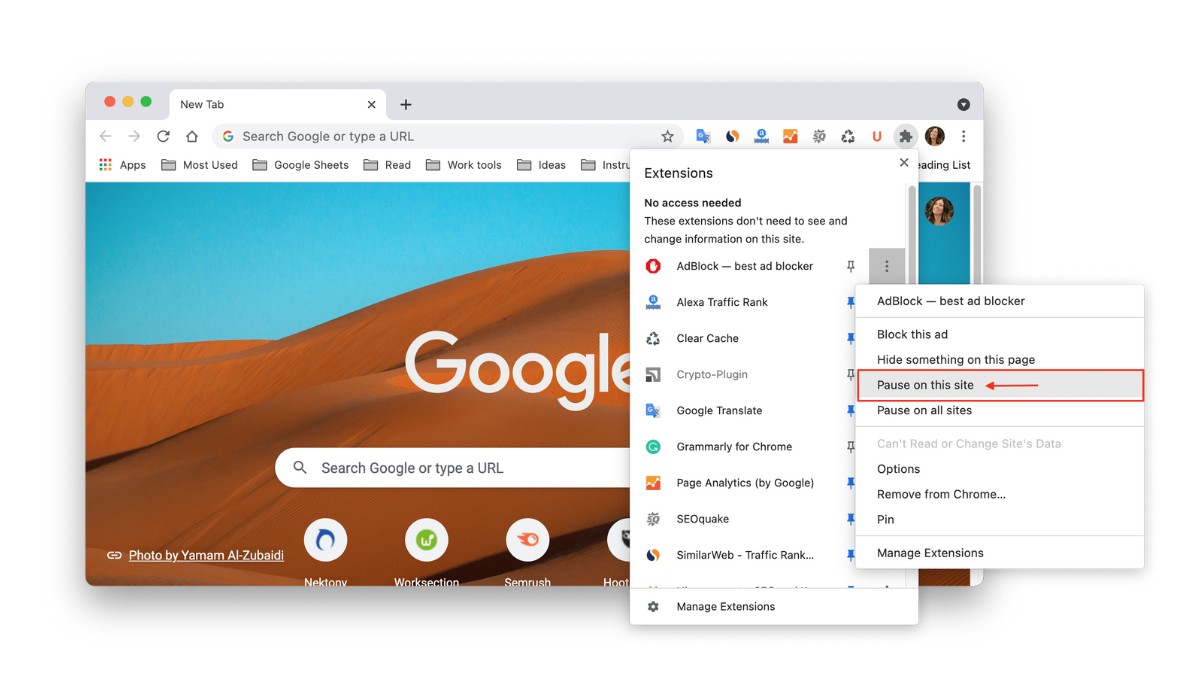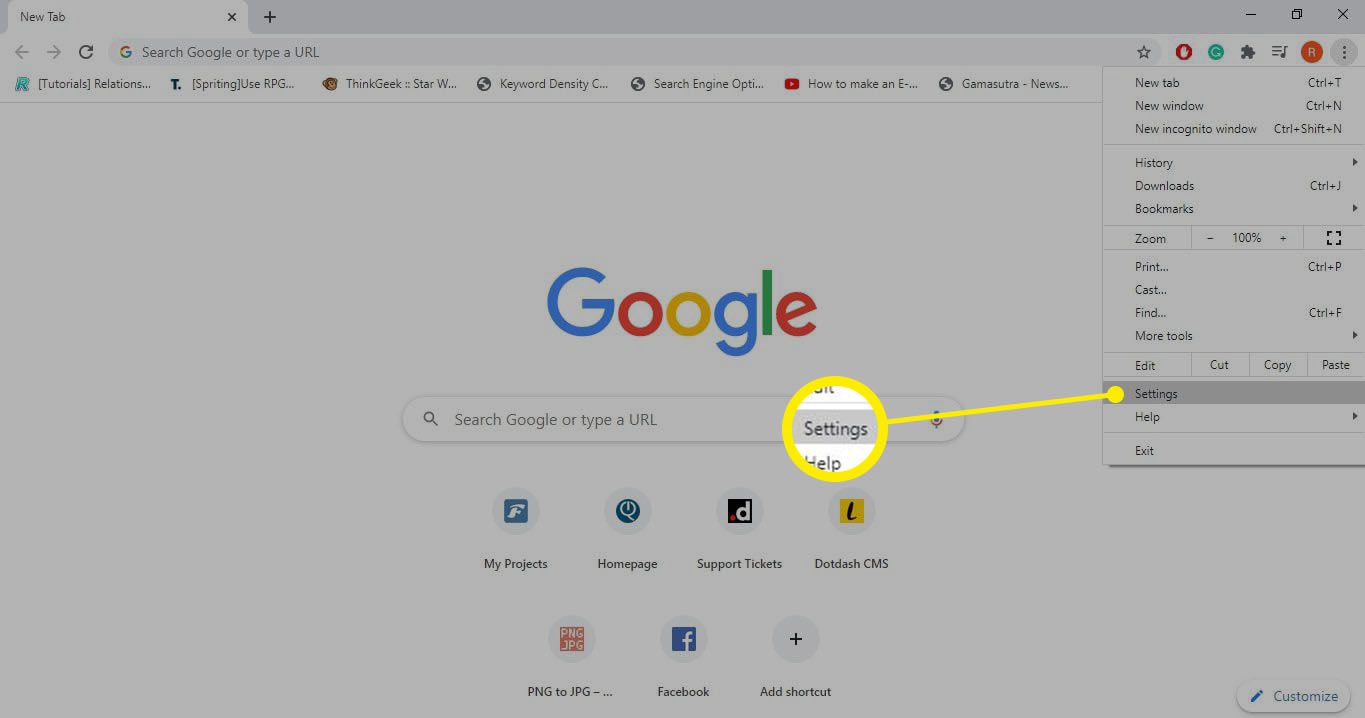Introduction
Are you tired of being bombarded with ads while browsing the web using Google Chrome? You're not alone. The prevalence of online advertisements can be overwhelming, disrupting your online experience and slowing down your browser. Fortunately, there are effective methods to alleviate this issue and enjoy a more streamlined browsing experience.
In this article, we'll explore various techniques to turn off ads in Chrome, allowing you to regain control over your online activities. Whether you prefer using built-in browser settings, leveraging ad-blocking extensions, or implementing advanced solutions like modifying the hosts file, we've got you covered. By the end of this guide, you'll be equipped with the knowledge and tools to significantly reduce or eliminate unwanted ads during your browsing sessions.
Let's dive into the methods and discover how you can bid farewell to intrusive ads and reclaim a clutter-free browsing environment. Whether you're a casual internet user or a seasoned web enthusiast, these strategies will empower you to take charge of your online experience and enjoy a more seamless and enjoyable browsing journey.
Method 1: Using Chrome Settings
Google Chrome offers built-in features that allow users to control and manage the display of ads. By utilizing these settings, you can customize your browsing experience and reduce the visibility of unwanted advertisements. Here's how you can leverage Chrome settings to minimize or disable ads:
1. Pop-up Blocker:
Chrome's pop-up blocker is a valuable tool for preventing intrusive pop-up ads from disrupting your browsing sessions. To enable this feature, simply access the Chrome settings by clicking on the three-dot menu icon in the top-right corner of the browser window. From the menu, select "Settings" and navigate to the "Privacy and security" section. Here, you can toggle the "Pop-ups and redirects" option to block unwanted pop-up ads, ensuring a smoother and less obtrusive browsing experience.
2. Ad Settings:
Google Chrome provides users with the ability to manage ad settings, allowing for greater control over the types of ads displayed during browsing. By accessing the "Settings" menu and selecting "Privacy and security," you can navigate to the "Site Settings" section. Within this menu, locate and click on "Ads" to access the ad settings. Here, you can choose to block certain ad categories or opt out of personalized ads, effectively reducing the frequency of targeted advertisements.
3. Safe Browsing:
Chrome's safe browsing feature serves as a defense mechanism against malicious ads and websites that may pose security risks. By enabling safe browsing, you can protect yourself from potentially harmful ads while browsing the web. To activate this feature, navigate to the "Privacy and security" section within Chrome settings and select "Security." From here, you can enable the "Safe Browsing" option, adding an extra layer of protection against deceptive ads and harmful content.
By leveraging these built-in Chrome settings, you can proactively mitigate the impact of ads during your browsing sessions. Whether it's preventing pop-up ads, customizing ad preferences, or enhancing security measures, Chrome empowers users to tailor their browsing experience according to their preferences and priorities. With these settings at your disposal, you can take significant strides towards minimizing the intrusion of ads and enjoying a more streamlined and personalized browsing journey.
Method 2: Using Ad Blocking Extensions
In the realm of digital advertising, ad blocking extensions serve as powerful tools for users seeking to minimize or eliminate the presence of ads during their browsing activities. These extensions are designed to intercept and block various forms of online advertisements, ranging from banner ads and pop-ups to sponsored content and video ads. By integrating ad blocking extensions into your Chrome browser, you can significantly enhance your browsing experience and reduce the visual clutter caused by intrusive ads.
One of the most popular ad blocking extensions for Chrome is AdBlock Plus. This robust extension effectively filters out ads from web pages, offering users a cleaner and more focused browsing environment. Upon installation, AdBlock Plus works silently in the background, analyzing web page elements and selectively blocking ad content without disrupting the overall functionality of the site. With customizable settings and filter lists, users can tailor their ad blocking preferences to suit their specific needs, ensuring a personalized and ad-free browsing experience.
Another noteworthy ad blocking extension is uBlock Origin, renowned for its efficiency and resource-friendly nature. This extension excels in blocking a wide array of ads while consuming minimal system resources, contributing to a smoother and faster browsing experience. uBlock Origin empowers users with advanced filtering capabilities, enabling them to fine-tune their ad blocking criteria and effectively combat intrusive ads across various websites. Its intuitive interface and comprehensive features make it a compelling choice for users seeking a seamless and ad-free browsing journey.
Furthermore, Privacy Badger stands out as an ad blocking extension that prioritizes user privacy and security. Developed by the Electronic Frontier Foundation (EFF), Privacy Badger functions as a privacy-focused ad blocker, safeguarding users against tracking scripts and invasive third-party ads. By intelligently identifying and blocking trackers and potentially harmful ad elements, Privacy Badger enhances user privacy while reducing the prevalence of unwanted ads, fostering a more secure and unobtrusive browsing experience.
By integrating these ad blocking extensions into your Chrome browser, you can take proactive steps to minimize the impact of ads and enjoy a more streamlined and distraction-free browsing experience. Whether you opt for AdBlock Plus, uBlock Origin, Privacy Badger, or other reputable ad blocking extensions, the ability to customize your ad blocking preferences empowers you to tailor your browsing environment according to your preferences, effectively reducing the intrusion of ads and enhancing your overall online experience.
Method 3: Using Hosts File
Modifying the hosts file is an advanced yet effective method to block ads at the system level, providing comprehensive ad blocking across all browsers and applications. The hosts file, located in the system's directory, serves as a mapping of domain names to IP addresses, allowing users to override DNS resolution and control access to specific websites.
To begin, users can access the hosts file by navigating to the system's directory, typically located at C:\Windows\System32\drivers\etc\hosts for Windows users and /etc/hosts for macOS and Linux users. It's important to note that modifying the hosts file requires administrative privileges on Windows, and root access on macOS and Linux.
Once the hosts file is accessed, users can add entries to block ad-serving domains by redirecting them to a non-existent IP address, effectively preventing the associated ads from being displayed. This process involves adding lines of code to the hosts file, specifying the target domain and the IP address to which it should be redirected.
For example, to block ads from a specific domain such as "www.advertisement.com," users can add the following line to the hosts file:
0.0.0.0 www.advertisement.com
By adding this entry, any attempts to access "www.advertisement.com" will be redirected to the non-existent IP address 0.0.0.0, effectively preventing the associated ads from being loaded.
Furthermore, users can leverage curated hosts files from reputable sources, such as "StevenBlack/hosts" on GitHub, which provide extensive lists of ad-serving domains and tracking sites. By integrating these curated hosts files into their own hosts file, users can significantly expand the scope of ad blocking, covering a wide range of ad-serving domains and enhancing their browsing experience.
While modifying the hosts file offers comprehensive ad blocking capabilities, it's important to exercise caution and ensure the accuracy of entries added to the file. Incorrectly modifying the hosts file can lead to network connectivity issues and unintended consequences, so users should proceed with care and follow best practices when implementing ad blocking through this method.
By utilizing the hosts file to block ads, users can achieve system-wide ad blocking, effectively reducing the visibility of ads across all browsers and applications. This method provides a robust and versatile approach to ad blocking, offering users greater control over their online experience and the ability to tailor their ad blocking preferences at the system level.
Conclusion
In conclusion, the prevalence of online advertisements can significantly impact the browsing experience, often leading to visual clutter, distractions, and potential security risks. However, by leveraging the methods outlined in this guide, users can effectively mitigate the intrusion of ads and regain control over their online activities.
From utilizing Chrome's built-in settings to integrating ad blocking extensions and leveraging the hosts file for system-wide ad blocking, users have a diverse array of tools at their disposal to tailor their browsing environment according to their preferences and priorities.
By harnessing Chrome's pop-up blocker, ad settings, and safe browsing feature, users can proactively manage the display of ads, prevent intrusive pop-ups, customize ad preferences, and enhance security measures. These built-in settings empower users to curate a more personalized and ad-free browsing experience within the Chrome browser.
Furthermore, the integration of ad blocking extensions such as AdBlock Plus, uBlock Origin, and Privacy Badger offers users the flexibility to selectively block various forms of online advertisements, ranging from banner ads and pop-ups to tracking scripts and invasive third-party ads. These extensions provide users with customizable ad blocking preferences, enabling them to tailor their browsing environment and reduce the visual clutter caused by unwanted ads.
For those seeking a comprehensive and system-wide ad blocking solution, the modification of the hosts file presents a powerful method to block ads across all browsers and applications. By redirecting ad-serving domains to non-existent IP addresses, users can effectively prevent the display of associated ads, significantly enhancing their browsing experience and reducing the visibility of intrusive advertisements.
In essence, the methods presented in this guide empower users to reclaim a clutter-free and personalized browsing environment, allowing them to focus on content that matters most to them. Whether it's enhancing security, minimizing distractions, or preserving user privacy, these methods offer valuable tools to curate a more seamless and enjoyable online experience.
By implementing these strategies, users can take proactive steps to minimize the impact of ads and enjoy a more streamlined and distraction-free browsing journey. With the knowledge and tools gained from this guide, users are well-equipped to navigate the digital landscape with greater control and confidence, ensuring a more enjoyable and personalized browsing experience.
























